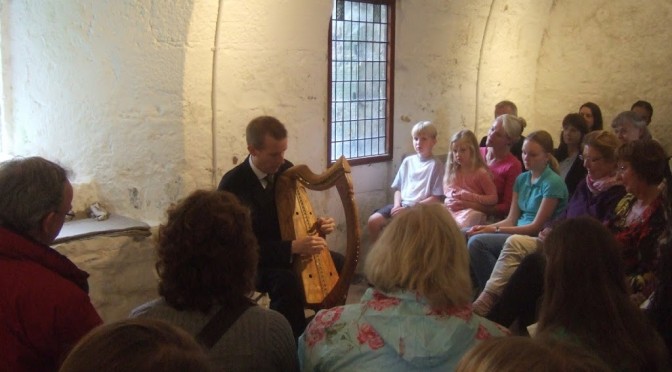On 4th July, I’ll be performing in the cathedral ruins in St Andrews, for the start of my summer series of medieval harp recitals.
Held in the atmospheric surroundings of the ruined cathedral, in the small and intimate vaulted medieval chamber of the Priors House, the concert features the beautiful decorated replica medieval clarsach of Mary, Queen of Scots. I’ll also play a set of tunes on the bowed-harp (bowed lyre, jouhikko, gue)
The programme for July’s event tells the story of Margaret of Scotland, 1281: The story of Scotland and Norway, the Royal Wedding and the lead up to the Wars of Independence.
Using a selection of medieval music and traditional tunes from Scotland and from Scandinavia, the late 13th century history and politics will be dramatically brought to life, as the old ballad says: “The King sat in Dunfermline Toun, drinking of the blood red wine…”
There will be only two cathedral recitals for 2013, due to funding cuts at Historic Scotland. The first concert will be Thursday 4th July; the second will be Thursday 1st August. The events start at 12.45pm.
Date and time:
Thursday 4th July, starting at 12.45pm, finishing around 1.15pm.
Venue:
St Andrews Cathedral
St Andrews, Fife, Scotland
Admission Free
Please collect a ticket from the Visitor Centre: 01334 472563
More info about the summer series at St Andrews Cathedral:
http://www.simonchadwick.net/cathedral/
Future events with Simon Chadwick in St Andrews:
Monday 15th July, 2pm, at the Museum of the University of St Andrews:
An Tarbh – Ranald and the Bull. ‘Pibroch’ music for the harp, composed by one of the last of the old Scottish harpers about three hundred years ago.
Thursday 1st August, 12.45pm, at St Andrews Cathedral ruins:
Colainn gun Cheann – Ranald and the Ghost. Atmospheric harp music telling the stories of supernatural exploits from the 18th century Highlands.














